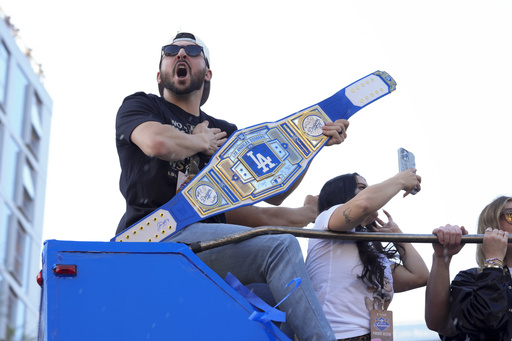SAN ANTONIO — This year’s World Series, which many anticipated would showcase an exciting clash between sluggers Aaron Judge and Shohei Ohtani, turned into a stage for lesser-known players such as Mark Leiter Jr., Luke Weaver, Alex Vesia, and Anthony Banda.
The Fall Classic highlighted the crucial role of a strong bullpen in baseball, especially during the playoffs. However, it has also raised concerns from various stakeholders, including prominent agent Scott Boras and the players’ association leader Tony Clark, regarding the potential overuse of pitchers.
Despite these worries, the pursuit of building an effective bullpen remains a formidable challenge for teams.
“Over the course of a season, you require numerous arms, and this need becomes even more pronounced during the postseason,” noted Perry Minasian, general manager of the Los Angeles Angels. “While securing quality pitchers is essential, quantity also plays a significant role. Where do you find those valuable arms?”
For casual baseball fans, the bullpen often goes unnoticed, particularly mid-relievers, who lack the spotlight typically given to ninth-inning closers. They labor in obscurity, consistently delivering crucial outs in high-pressure situations, much like offensive linemen in the NFL, who are only acknowledged when something goes awry.
The Dodgers featured pitchers like Vesia, Banda, and Michael Kopech prominently throughout the World Series, with others such as Blake Treinen and Brusdar Graterol also playing pivotal roles. Collectively, these pitchers managed to cover 15 1/3 innings, often in critical moments, while allowing only five runs.
This equates to an impressive 2.93 ERA, especially for players who may not be widely recognized.
“I have a solid group of players, and they know it’s all about securing 27 outs every night,” stated Dodgers manager Dave Roberts. “Anyone can step up at any given time.”
Crafting a successful Major League bullpen is particularly appealing since financial constraints are less of an issue than in other positions. This makes it one of the fairest roles in a sport without a salary cap. For instance, Banda earned $740,000, Vesia was at $1 million, Treinen also made $1 million, Kopech earned $3 million, and Graterol was paid $2.7 million, all negligible compared to Ohtani’s staggering $700 million, 10-year contract signed last offseason.
Ultimately, it boils down to scouting, development, and sometimes plain luck. In fact, it often resembles more of an art form than a strict science.
“I wish we had the answer,” commented Erik Neander, president of baseball operations for Tampa Bay. “Then we could have won more games last year.”
Boras has expressed discontent about the current usage of relief pitchers. For example, Clay Holmes appeared in all five of the World Series games for the Yankees, leading to concerns that pitchers, especially relievers, are being pushed to the brink in October.
“We must reconsider how we’re utilizing our talented young pitchers and change our approach to prevent overexertion during critical playoff moments,” Boras urged.
Over the last decade, average fastball velocities have shot up from 93.3 mph to 95.5 mph during the 2024 regular season, while injury rates have surged, with 484 pitchers ending up on the injured list this year—almost double the total from 2014.
The rise in injuries adds to the complexity for general managers navigating bullpen strategies.
Utilizing talented young arms in relief roles can be perilous, yet securing seasoned relievers via free agency also presents its own risks. For instance, Treinen’s career illustrates the unpredictable nature of bullpens.
He was an All-Star in 2018 for the Oakland Athletics, boasting a remarkable 0.78 ERA with 100 strikeouts in 80 1/3 innings. However, he saw his performance plummet to a 4.91 ERA the following season.
The Dodgers took a chance on him in 2020, and he rebounded effectively, helping the team clinch a World Series title. After this success, they signed him to a two-year extension. Despite being effective again in 2021, a serious shoulder injury sidelined him for nearly the entire 2022 season.
Although he signed an extension, he would not see action again until 2024, where he recorded a 1.93 ERA and contributed to yet another championship.
Now Treinen is once again a free agent.
“There are various perspectives to explore,” said Minasian, speaking on the larger topic of bullpen management. “You could think, ‘Man, he’s pitched a lot; there’s concern about future performance because of his heavy usage over the past few years.’ Conversely, you could also consider, ‘He’s been durable, consistent, and can take the mound regularly.’”
The Houston Astros have established a strong bullpen in recent years, employing pitchers like Hector Neris and Ryan Pressly. General manager Dana Brown acknowledges the inherent unpredictability of bullpen performance, suggesting that not all volatility stems from injuries.
“Such fluctuations are part of the modern game,” remarked Brown. “With all the information available, hitters often study pitchers intensively, identifying weaknesses to exploit.”
He emphasized that a quality he values in relievers is humility, recognizing the need to adapt their strategies as they advance through their careers.
“Pitchers lacking a teachable attitude may find themselves lost in the game,” added Brown.


